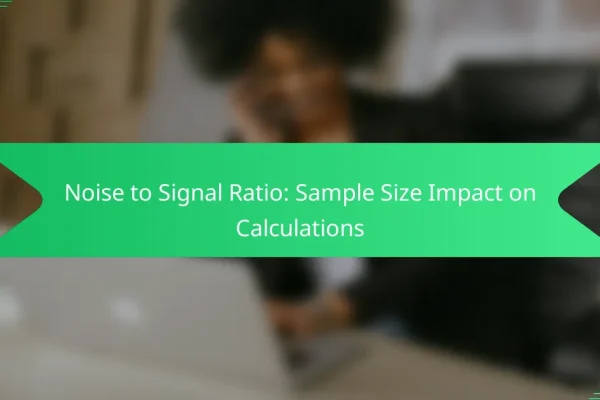
Noise to Signal Ratio: Sample Size Impact on Calculations
The noise to signal ratio (NSR) is profoundly influenced by sample size, as it directly…
The noise to signal ratio (NSR) is a critical concept in data analysis that measures the clarity of information by comparing the level of unwanted noise to the actual signal. A high NSR can lead to misinterpretations, making it essential to employ techniques such as data filtering and machine learning to improve this ratio. Understanding and optimizing NSR is vital for enhancing decision-making and ensuring reliable outcomes in various fields.

The noise to signal ratio (NSR) is profoundly influenced by sample size, as it directly affects the reliability of research outcomes. Larger sample sizes tend to provide a clearer signal by minimizing noise, thereby enhancing the accuracy of the results. Properly determining the sample size is essential for obtaining valid insights, and utilizing statistical methods…

The noise to signal ratio (NSR) is a critical metric in business data analysis, as it determines the clarity and reliability of information. By utilizing specialized software tools, organizations can filter out irrelevant data, enhancing their ability to extract actionable insights. Effective analysis involves identifying noise sources, quantifying their impact, and applying various statistical methods…

In the dynamic landscape of social media, businesses must strive to improve their noise to signal ratio by prioritizing quality content and meaningful audience engagement. Leveraging advanced analytics tools enables companies to gain valuable insights into audience interactions and content performance, guiding data-driven decisions. By tracking key engagement metrics, such as likes, shares, and reach,…

Assessing the noise to signal ratio (NSR) in real-time data streams is crucial for understanding the quality and reliability of the information being processed. By measuring the unwanted variations against meaningful data, organizations can gain insights into the integrity of their data. Implementing effective tools and practices for NSR evaluation allows for better data quality…

The noise to signal ratio plays a crucial role in business decision-making by affecting the clarity and reliability of data insights. A high level of noise can obscure valuable signals, resulting in poor decisions and missed opportunities. By improving this ratio through targeted strategies and advanced analytics, businesses can enhance data clarity and make more…

The noise to signal ratio is a critical concept in financial data analysis, as it determines the clarity and reliability of the information used for decision-making. By leveraging advanced analytics, machine learning, and effective data visualization, businesses can enhance this ratio, filtering out irrelevant noise to uncover valuable insights. Understanding key metrics such as signal…

The noise to signal ratio (NSR) is a critical metric in data analysis that influences the clarity and reliability of information across various technological applications. Enhancing the NSR involves utilizing techniques such as data filtering and advanced signal processing, which aim to reduce unwanted noise and improve the accuracy of the desired signal. With tools…

Enhancing the noise to signal ratio in survey design is essential for extracting meaningful insights while reducing irrelevant data. By focusing on clear question formulation, effective sampling, and advanced analysis techniques, researchers can overcome common challenges such as ambiguous phrasing and bias. Ultimately, presenting survey results in a straightforward manner helps to clarify key findings…

In the realm of data analysis, selecting the right analytical tool is crucial for optimizing the noise to signal ratio, which helps in filtering out irrelevant information and gaining clearer insights. The ideal tool should align with your specific analytical needs, whether it be data visualization, reporting, or statistical analysis, while also considering user preferences…

In today’s data-driven world, AI tools play a crucial role in enhancing noise to signal ratio analysis by automating data processing and clarifying relevant signals. By leveraging advanced algorithms, these technologies effectively filter out irrelevant data, leading to more accurate insights and improved decision-making. Selecting the right AI tool requires careful consideration of your specific…
Improving the noise to signal ratio in data analysis involves employing various techniques to enhance the clarity of the data while minimizing irrelevant information. Key strategies include data filtering, signal enhancement, statistical analysis, and leveraging machine learning algorithms.
Data filtering techniques focus on removing unwanted noise from datasets. Common methods include low-pass filters, which allow signals below a certain frequency to pass while attenuating higher frequencies, and band-pass filters that only allow a specific range of frequencies through.
When applying these techniques, consider the type of data you are working with. For instance, in audio processing, a low-pass filter can effectively reduce high-frequency noise, while in image processing, spatial filters can help smooth out pixel variations.
Signal enhancement methods aim to improve the quality of the desired signal. Techniques such as averaging multiple measurements can help reduce random noise, while techniques like wavelet transforms can isolate and enhance specific features of the signal.
For example, in time-series data, using moving averages can smooth out fluctuations, making trends more apparent. However, be cautious as excessive smoothing can lead to loss of important details.
Statistical analysis tools are essential for quantifying the noise to signal ratio and making informed decisions. Techniques such as regression analysis can help identify relationships between variables and filter out noise by focusing on significant predictors.
Utilizing software like R or Python's statistical libraries can facilitate these analyses. Ensure to validate your models with cross-validation techniques to avoid overfitting, which can mask the true signal.
Machine learning algorithms can significantly enhance the noise to signal ratio by learning patterns in data. Algorithms such as random forests or support vector machines can effectively classify and separate signals from noise based on training data.
When implementing machine learning, ensure to preprocess your data adequately. Techniques such as feature selection can help eliminate irrelevant features, improving the model's performance and clarity of the signal.
Achieving an optimal noise to signal ratio (NSR) is often hindered by several challenges that can affect the clarity and reliability of data. Key issues include data quality, measurement errors, and environmental factors that can introduce unwanted noise into the signal.
Poor data quality is a primary challenge in maintaining a good noise to signal ratio. Inaccurate or incomplete data can obscure the true signal, making it difficult to distinguish relevant information from noise. For instance, missing data points or outliers can significantly skew results.
To mitigate these issues, ensure that data collection methods are robust and that data is cleaned and validated before analysis. Regular audits of data sources can help identify and rectify quality concerns early in the process.
Measurement errors can arise from faulty equipment or improper calibration, leading to inaccuracies in the recorded signal. These errors can introduce noise that distorts the actual data, affecting the overall noise to signal ratio. For example, using outdated sensors may yield inconsistent readings.
To minimize measurement errors, implement routine calibration of instruments and adopt standardized measurement protocols. Training personnel on proper measurement techniques can also reduce human error, enhancing the reliability of the data collected.
Environmental factors such as temperature fluctuations, electromagnetic interference, and physical obstructions can contribute to noise in the signal. For example, high levels of ambient noise in industrial settings can mask important signals, making it challenging to achieve a favorable noise to signal ratio.
To address these environmental challenges, consider conducting measurements in controlled settings whenever possible. Additionally, using shielding techniques or noise-canceling technologies can help reduce the impact of external noise on the signal being analyzed.
The noise to signal ratio (NSR) significantly affects decision-making by determining the clarity and reliability of the information used. A high ratio indicates more noise than signal, leading to potential misinterpretations and poor choices.
A high noise to signal ratio can distort data interpretation, making it difficult to identify trends or patterns. When noise overwhelms the signal, decision-makers may draw incorrect conclusions based on misleading information.
For instance, in financial markets, if the noise from market chatter exceeds the actual market signals, investors might react to false trends, resulting in suboptimal investment decisions. It is crucial to filter out noise to focus on relevant data that drives accurate interpretations.
The noise to signal ratio directly impacts the effectiveness of predictive modeling. Models trained on data with a high NSR may produce unreliable forecasts, as the noise can obscure the underlying relationships between variables.
To improve model accuracy, practitioners should strive to reduce noise through data cleansing and feature selection. For example, using only high-quality data points can enhance model performance, leading to predictions that are more aligned with actual outcomes.
Several tools can effectively measure noise to signal ratio (NSR), including software packages and programming libraries. These tools provide functionalities for analyzing signals, processing data, and calculating the NSR in various contexts.
MATLAB is a powerful tool widely used for signal processing, offering built-in functions to compute noise to signal ratio. Users can utilize functions like snr() to directly calculate NSR from signal and noise data.
MATLAB's extensive documentation and community support make it easier for beginners to learn how to analyze signals effectively. Additionally, its graphical capabilities allow for visualizing signals and their noise components, enhancing understanding.
Python, with libraries such as SciPy and NumPy, provides robust options for measuring noise to signal ratio. The scipy.signal module includes functions that can help in filtering signals and estimating NSR.
Python's versatility allows users to customize their analysis pipelines, making it suitable for various applications, from audio processing to scientific research. Moreover, the open-source nature of Python encourages collaboration and sharing of code among users.
R is an excellent choice for statistical analysis and can be used to measure noise to signal ratio through various packages. The signal package in R provides functions for analyzing and visualizing signals, including calculating NSR.
R's strong statistical capabilities make it ideal for users needing to perform complex analyses on their data. Its extensive libraries and community support facilitate learning and applying NSR calculations in different research fields.
The noise to signal ratio (NSR) is crucial in telecommunications as it measures the level of background noise relative to the desired signal. A lower NSR indicates clearer communication, while a higher ratio can lead to degraded performance and misunderstandings.
Signal clarity is directly affected by the noise to signal ratio. A low NSR means that the signal is much stronger than the noise, allowing for clear audio or data transmission. In contrast, a high NSR can obscure the signal, making it difficult for receivers to interpret the information accurately.
For example, in voice communication, an NSR of 20 dB or higher is generally considered acceptable for clear conversations, while anything below that may result in noticeable interference and misunderstandings.
The noise to signal ratio plays a significant role in determining how bandwidth is allocated in telecommunications. Higher NSR values may require more bandwidth to maintain quality, as the system needs to compensate for the noise interference. Conversely, a lower NSR allows for more efficient use of available bandwidth.
Telecommunications providers often assess NSR when planning network capacity and infrastructure. For instance, in urban areas with high traffic, maintaining a low NSR might necessitate allocating additional bandwidth to ensure reliable service.